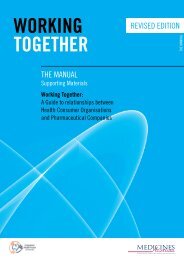Coping with persistent pain - Chronic Pain Australia
Coping with persistent pain - Chronic Pain Australia
Coping with persistent pain - Chronic Pain Australia
Create successful ePaper yourself
Turn your PDF publications into a flip-book with our unique Google optimized e-Paper software.
Ways of taking opioids<br />
Concerns relating to opioid therapy<br />
There are several routes of administration for analgesics. The choice<br />
of route usually depends on the nature of the drug, the condition of<br />
the patient, and the nature and urgency of the <strong>pain</strong>. For the majority<br />
of people, the preferred route is oral (by mouth), however, other<br />
options are available.<br />
Suppositories are available for administration by the rectal route,<br />
but patients may not find this acceptable.<br />
Besides oral medicines (i.e. tablets, capsules and liquids) another<br />
easy non-invasive way of taking medicines is by a transdermal patch<br />
delivery system (fentanyl and buprenorphine are the only opioids<br />
available in this form).<br />
The delivery of a drug across the skin may vary and can be affected<br />
by several factors. Heat can affect the amount of medicine released<br />
from the transdermal patch. Patients should not expose the patch<br />
to direct heat from hot water bottles, heating pads, electric blankets,<br />
heat lamps, hot spa baths, saunas, etc. 13 Normal physical activity<br />
is generally OK. If you have any questions discuss them <strong>with</strong> your<br />
doctor or healthcare professional.<br />
A further problem may arise in patients <strong>with</strong> sensitive skin, who may<br />
suffer reactions on the skin at the patch application site. If this happens,<br />
speak to your GP, pharmacist or <strong>pain</strong> specialist.<br />
Opioid therapy may be used when the benefits of treatment outweigh<br />
the possible harm they may do. However, it is important to set treatment<br />
goals, which include setting a maximum (or ceiling) dose to be used.<br />
Treatment should be reviewed by the doctor if the maximum dose<br />
does not provide adequate <strong>pain</strong> relief.<br />
The body’s normal response to the continued use of opioids is<br />
physical dependence and tolerance. 14<br />
Physical dependence occurs when a person’s body adapts to a<br />
medicine. If someone has become physically dependent on a medicine<br />
and suddenly stops taking it, <strong>with</strong>drawal may occur. These symptoms<br />
can include muscle aches, watery nose and eyes, irritability, sweating,<br />
and diarrhoea. Physical dependence is a normal response when opioids<br />
are used for more than 7–10 days. Physical dependence is different to<br />
psychological dependence (or addiction). Your doctor will provide advice<br />
on how to minimise or manage any side effects.<br />
Tolerance is when one or more effects of a medicine become less <strong>with</strong><br />
repeated use at the same dose (many people say it is like becoming<br />
‘immune’ to the medicine). For example the first time you take the<br />
medicine, you might feel quite drowsy <strong>with</strong> just one pill, but <strong>with</strong> continued<br />
use you might need several pills to feel anything. With opioids most people<br />
quickly become tolerant to the sedating effects, but will not develop<br />
tolerance to constipation.<br />
Addiction (or psychological dependence) is an overwhelming<br />
need to use a particular medicine or drug. People <strong>with</strong> a drug addiction<br />
develop an uncontrollable need to use the drug. Opioids may produce<br />
psychological dependence if used for the wrong reason by people who<br />
have the potential to develop a drug addiction. Opioids should always be<br />
used <strong>with</strong> caution especially in these individuals.<br />
If opioids are prescribed for your <strong>pain</strong>, you are not abusing drugs if you<br />
are taking the medicine as prescribed. Taking doses of opioid medicine<br />
to relieve <strong>pain</strong> is not the same as taking them to get high.<br />
Remember, if you have any questions about your condition or the<br />
medicines you are taking talk to your healthcare professional.<br />
34<br />
35















